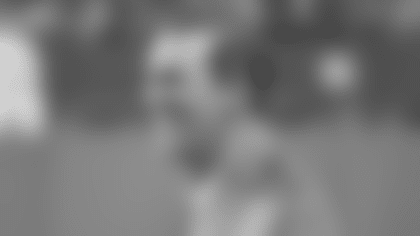This won't be the first time Marc Trestman has followed up on Gary Kubiak's offensive success.
In 1995, Trestman arrived in San Francisco as their offensive coordinator and quarterbacks coach after Kubiak and Mike Shanahan left for Denver.
Two decades later, the situation is eerily similar.
In his one year as offensive coordinator, Kubiak guided the Ravens to franchise records in points and yards per game. Now Trestman will be charged with maintaining, or improving on, that kind of production.
Trestman isn't going to change much.
The Ravens will still run the same West Coast system ushered in by Kubiak under Harbaugh's watch. The general language and blocking scheme will remain the same. Trestman says he will abide by the Ravens' balanced, physical running attack.
"It's never going to be my offense. It's always going to be the Ravens offense," Trestman said Wednesday during his introductory conference call.
"I think the framework and the formula for this is for me to go in and learn the offense. … Why would I have 40-some guys learn a new offense when I'm just one person? Isn't it easier for me to learn it instead of starting over with everybody else, including coaches?"
Trestman's flexibility to adapt to the Ravens offense was one of the chief reasons he was hired.
As Head Coach John Harbaugh said, "I'm the one who sets the philosophy as the head coach. You decide what the philosophy is going to be and you bring people into your organization who are going to best carry that forward."
One of the biggest questions is how much Trestman will run the football. The Ravens rebounded on the ground last year under Kubiak's run-first approach. They went from last in the NFL in 2013 with 3.1 yards per carry to the seventh-best rushing offense last year at 4.5 yards per rush.
Baltimore ran the ball 448 times last year (11th-most in the league), while the Bears ran 355 times (30th) under Trestman's watch. In his 10 seasons as an NFL play caller, Trestman's offenses have finished in the top 10 in rushing yards per game once.
"John has a vision of playing complementary football. That's what allowed the Ravens to be so successful," Trestman said. "That's something I paid attention to and will certainly have in mind each and every day as we work within the framework of the offense."
Harbaugh made it clear what he wants.
"I don't know what [Trestman is] known as or who knows him as what," Harbaugh said. "We have a way we want to play and a system in place. We've been running the ball here for a long time. That's been our philosophy and our belief. Marc understands that. Marc has run the ball in [add] different places and had a ton of success, [comma] too."
Trestman used his chief running back, Matt Forte, a lot in Chicago. Forte ran 289 times for a career-high 1,339 yards and nine touchdowns in 2013. Forte dipped to 266 carries and 1,038 yards last season, but caught a team-high 102 passes for 808 yards and four scores.
The Ravens offensive linemen loved Kubiak's run blocking scheme, and that will remain the same, Harbaugh confirmed. Baltimore started primarily running the stretch-zone run scheme in 2010 and Kubiak and the coaches he brought from Houston "took that to another level" in terms of the nuances, Harbaugh said.
"That's what they've been doing all those years in Houston and Denver. They're probably the foremost guys to run the stretch-zone," Harbaugh said. "We've learned from that and that's a part of us going forward, and we'll keep it."
In terms of the passing game, Trestman used a lot of shotgun formation with quarterback Jay Cutler, but says he's not married to that. He said that when he was offensive coordinator in Oakland in 2002, when the Raiders went to Super Bowl XXXVII, the Raiders never used the shotgun.
The Bears also operated with a lot of bigger-bodied receivers with Brandon Marshall, Alshon Jeffrey and tight end Martellus Bennett. Trestman said he'll work with whomever the Ravens give him.
"I think it's all based on strengths and weaknesses," Trestman said. "It's a process of what do your guys do best and how does everything fit together. I've had so many different systems in so many different places that flexibility is certainly part of how I feel the process is going to work."


















